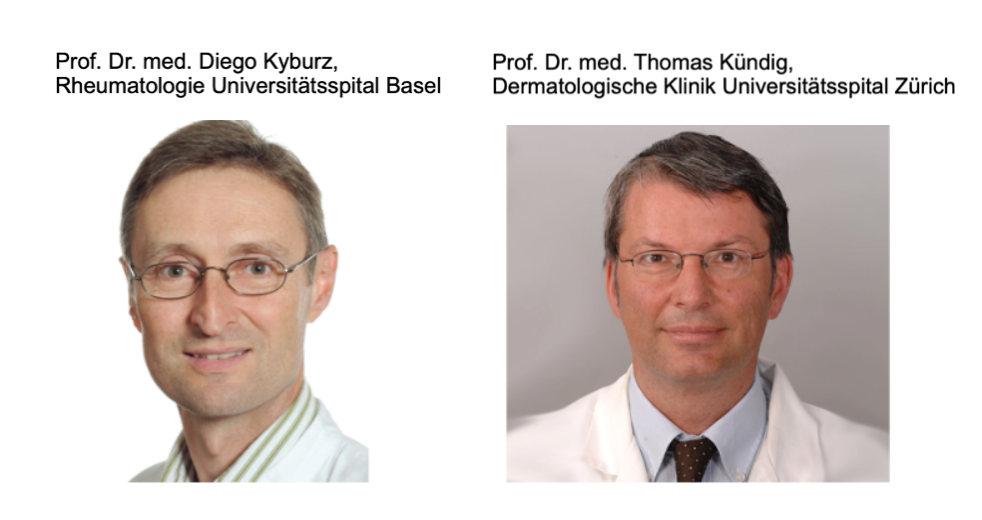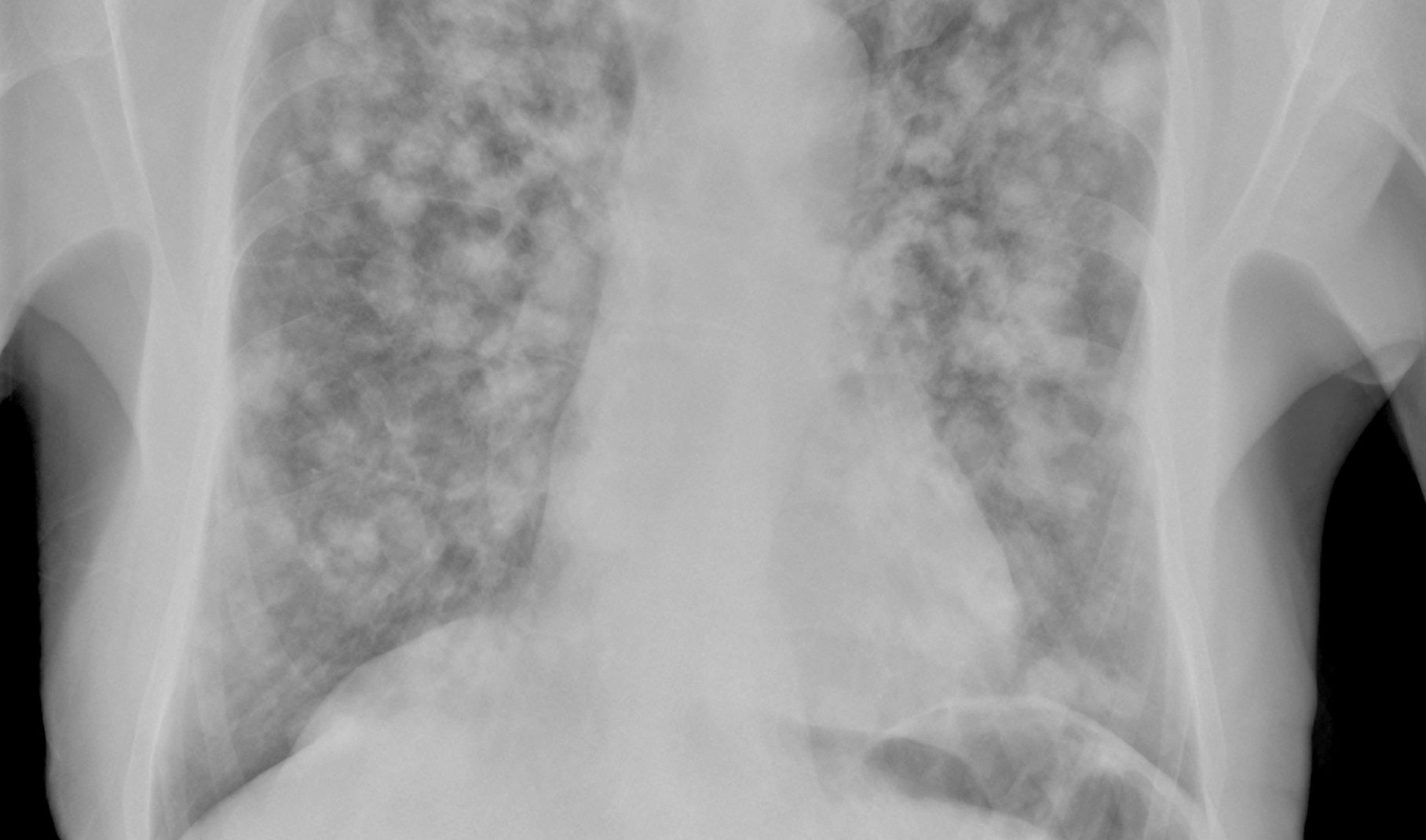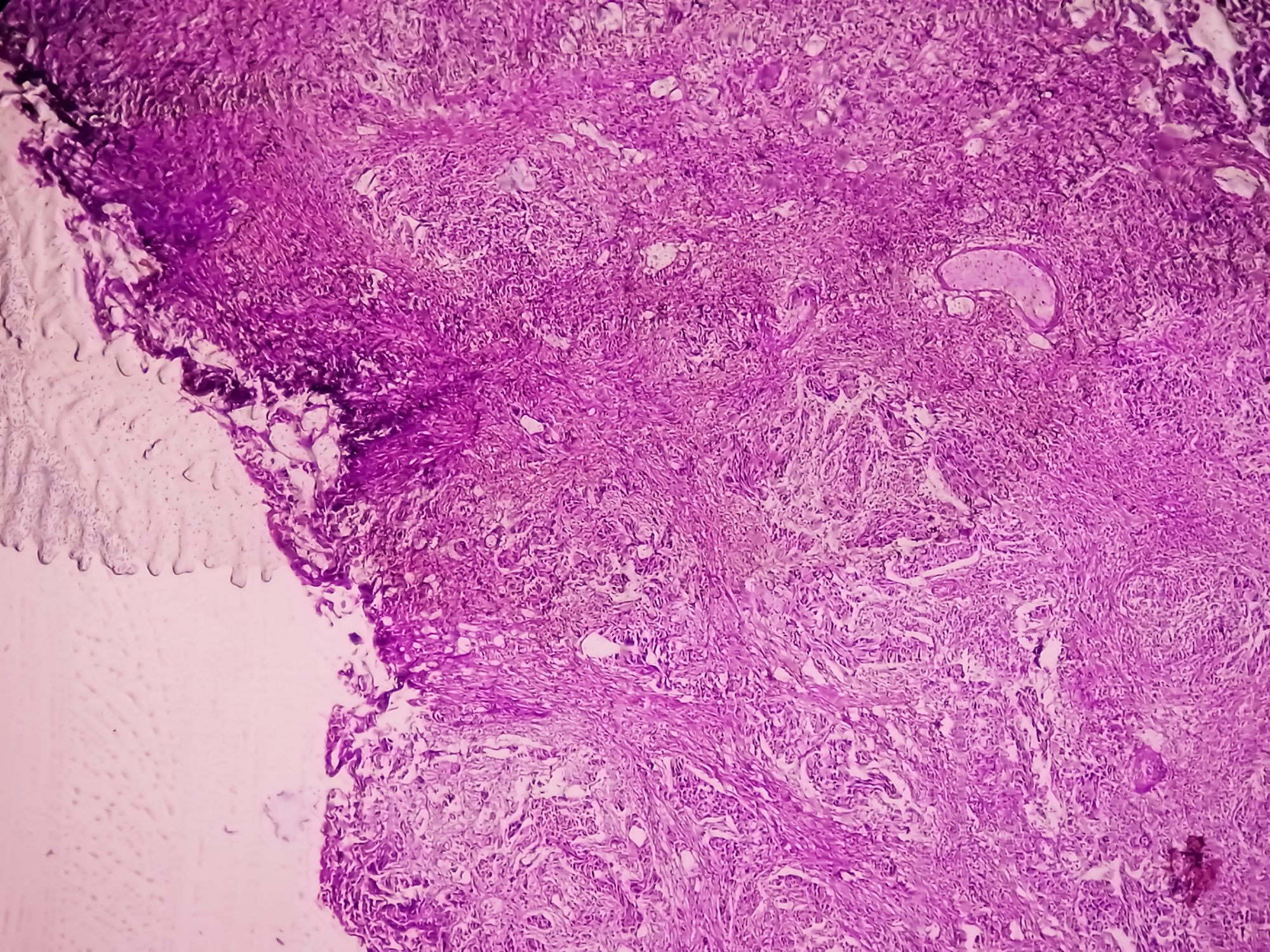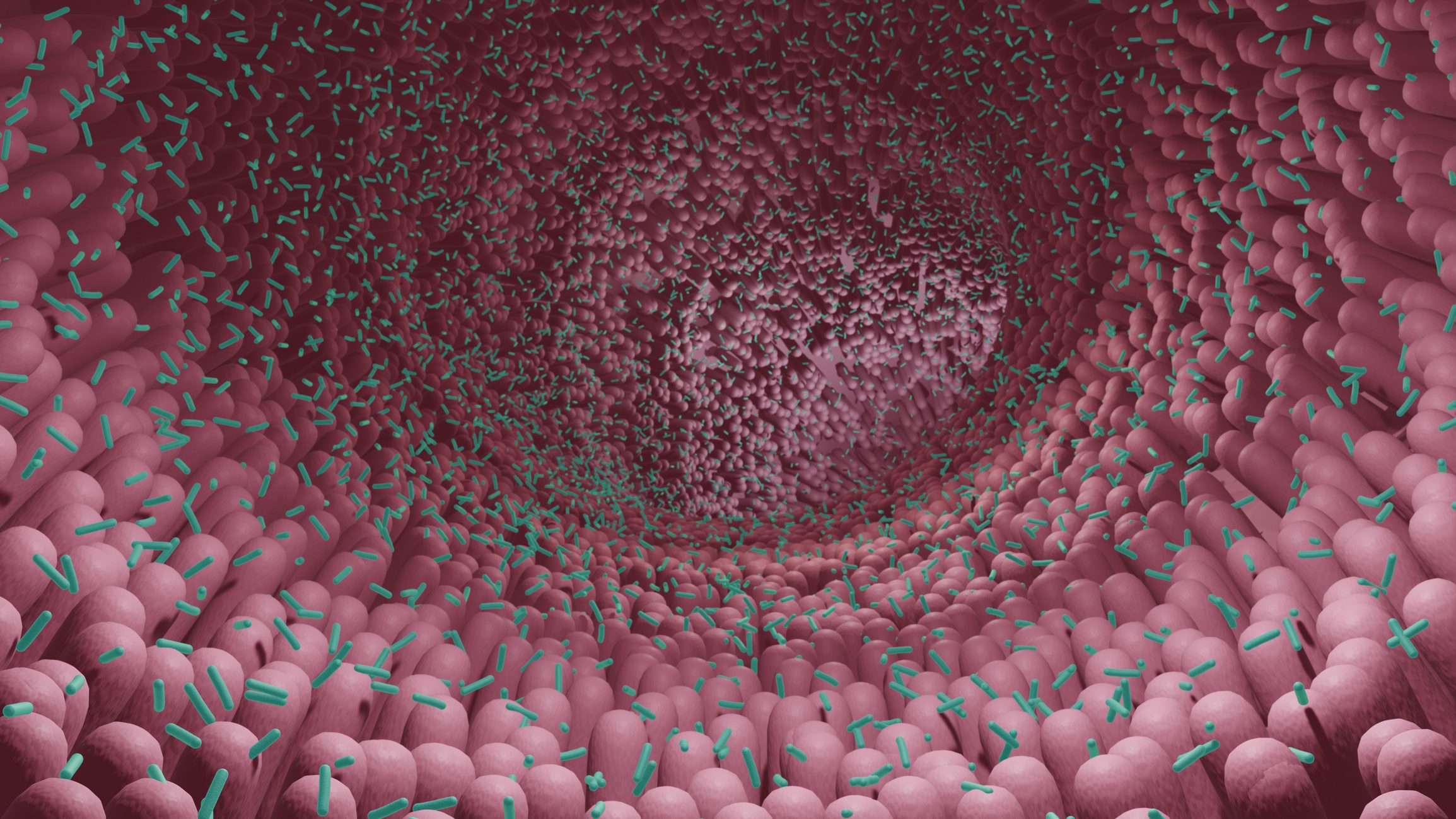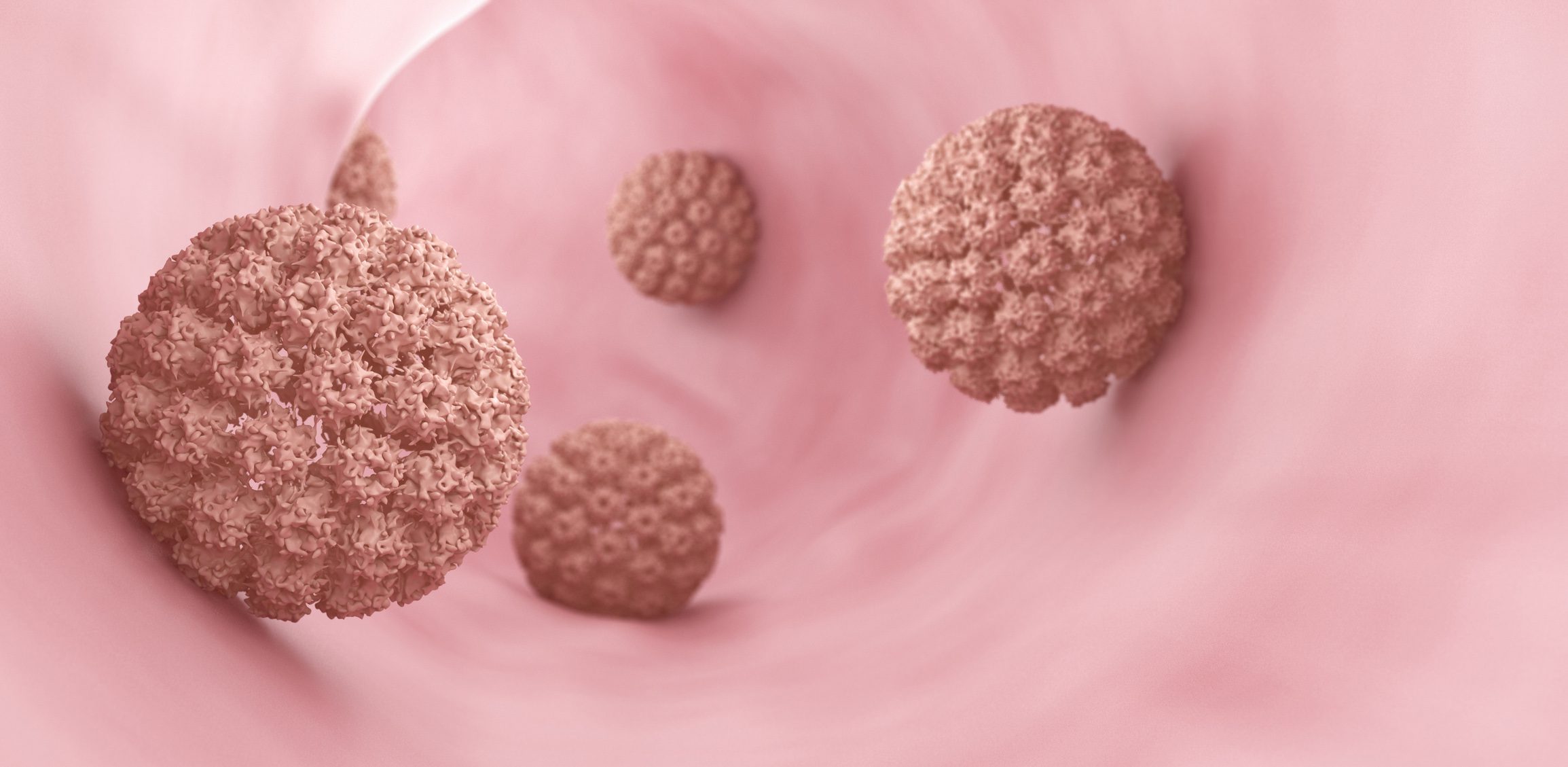In Switzerland, psoriasis affects about 1 to 3 percent of the population [1]. About one in three psoriasis patients also suffers from psoriatic arthritis (PsA), a chronic inflammatory systemic disease that can manifest itself in arthritis, enthesitis, and dactylitis, among other things [2, 3]. If left untreated, PsA can result in joint destruction and even disability [2]. In the following interview, dermatologist Prof. Thomas Kündig and rheumatologist Prof. Diego Kyburz discuss the interdisciplinary management of this complex disease and elaborate on two current therapeutic options [4, 5].
1. PsA is a very complex disease, both the skin is affected and diverse manifestations in the musculoskeletal apparatus – What possibilities do you see in the treatment of your PsA patients today?
Prof. Kündig:
We dermatologists primarily take care of skin manifestations that patients find very disturbing and often lead to stigmatization. Fortunately, however, we have highly effective drugs available for the treatment of skin symptoms, with which we aim to achieve a 100 percent response. We usually achieve this and the patients are freed from all visible skin changes; sometimes a change of the medication is necessary for this. For early clarification of possible joint involvement, we now send all psoriasis patients to a rheumatologist. This is because in a survey only 15% of patients report joint problems, but in a rheumatological workup a manifestation in the joints is found in 30% of patients. If this is the case, we delegate the patient’s treatment almost entirely to the rheumatologist. Because if the accompanying arthritis is well managed therapeutically, this also has a positive effect on the skin, which seems to be easier to treat than the joints.
Prof. Kyburz:
Here we are actually sometimes a little envious of dermatologists, who often achieve complete relief from skin manifestations. It is true that we are now achieving very good response rates also with regard to joint manifestations, and most patients are doing much better with the drugs available today. But only in a minority do the disease manifestations disappear 100%. It is important for a drug to be as broadly effective as possible. This is because, in addition to the skin and joints, the tendon attachments, for example, can also be affected or other manifestations can be added. It is not sufficient to control only one component if other components, such as dactylitis, remain active. We are therefore trying to find a drug that optimally treats all domains.
Prof. Kündig:
Dermatologists also have more time than rheumatologists to adjust their patients to therapy. Psoriasis-related skin manifestations do not leave scars after healing. However, complications can arise with arthritis, so effective treatment should be initiated as early as possible.
Prof. Kyburz:
The use of biologics achieves very good results in psoriasis. It would be exciting to analyze whether psoriasis patients who receive early biologics experience less frequent progression and whether this reduces the number of PsA cases overall.
Prof. Kündig:
In the long run, one would assume. This is because in many inflammatory diseases, outcomes are better when effective medications are used early. One must stop treating psoriasis as a skin disease only. Psoriasis is an inflammatory systemic disease for which systemic treatment is preferable to prevent the occurrence of comorbidities.
2. Treating PsA successfully is challenging. To what extent do the IL-23 inhibitor fulfill Risankizumab (SKYRIZI®) and the Janus kinase inhibitor (JAKi) Upadacitinib (RINVOQ®) meet these high requirements?
Prof. Kündig:
Risankizumab works very well against the skin manifestations of psoriasis and PsA. We strive for a PASI 100, or appearance-free skin, when treating our patients. However, because of the potential long-term damage to the musculoskeletal apparatus, the focus should be on the joints. If a therapy (e.g. with Upadacitinib) works well on the joints, but the patient still has skin manifestations, we can still help here with local therapy.
Prof. Kyburz:
Both drugs show broad efficacy. Upadacitinib has also been shown to have an effect on axial inflammation.
Prof. Kyburz:
Janus kinase inhibitors (JAKi) Inhibitors are a good therapeutic option because they inhibit not only one but several cytokines and thus have a broad spectrum of activity. However, the increased incidence of cardiovascular events in elderly patients and an increased rate of malignancies [unter Tofacitinib in der ORAL Surveillance-Studie] have led to uncertainty regarding the use of JAKi. It is still unclear whether these concerns are valid for all representatives of JAKi, which differ in their selectivity. Further safety studies are needed here.
Prof. Kündig:
In the case of JAKi, as was the case with biologics at the time, a lot of educational work needs to be done. We often still talk about JAKi in general terms – that’s kind of like putting the TNF inhibitor and IL-17 inhibitor in the same box. A clear distinction must be made here.
Prof. Kyburz:
To return to the ORAL Surveillance study: This included high-risk patients who are normally excluded in pivotal trials. Thus, while much has been learned from the study, one should not have fundamental reservations about the use of JAKi based on the results. It is important to assess the risk and benefit for individual patients in order to find the optimal therapy.
3. The indication of risankizumab with psoriasis and PsA and upadacitinib with rheumatoid arthritis (RA),
ankylosing spondylitis
, atopic dermatitis, and PsA is very broad.
[4, 5]
. What advantages do you see in this regard for the collaboration between dermatologist and rheumatologist?
Prof. Kyburz:
When we see patients with skin involvement, we are very happy to have the dermatological opinion in terms of the optimal therapeutic option. In this case, discussing the management of the disease together from the beginning is an advantage, and you will reach your goal faster. Especially when visible areas of the skin are affected, this can be accompanied by great restrictions for the patients. To get this under control, we need the dermatologist.
Prof. Kündig:
Risankizumab is a commonly used therapy when skin involvement is present – not only because of its good response, but also mainly because of its convenience for patients. It is also more popular than a drug that needs to be injected every month because it only needs to be injected four times a year during the maintenance phase. This makes a big difference for patients – you can forget about the disease most of the time.
Prof. Kyburz:
I agree with that. Upadacitinib, which is taken as a tablet, is also very interesting in terms of convenience.
4. How do you see the future of personalized treatment in light of the ever-expanding treatment repertoire?
Prof. Kündig:
Modern therapies are usually so successful with respect to the skin that we often make the decision to use a drug based on convenience for the patient, as I mentioned earlier. In this respect, there is not much need for a test that predicts response to a particular drug. But an interesting question is whether you can eventually discontinue a drug in a patient who has responded completely to it for years. Is there a marker that can predict which patient will remain symptom-free after discontinuation? In dermatology, it is relatively risk-free to try discontinuing therapy in the meantime. This is different in rheumatology, where you risk permanent joint damage.
Prof. Kyburz:
We would be happy to have biomarkers, especially for treatment response in certain subgroups. Patients with dactylitis in particular are often relatively resistant to therapy. If we could predict here which drug these patients would respond best to, that would be very helpful. However, unfortunately, it is not so easy to find such biomarkers. We examined predictors of successfully discontinuing biologics therapy in RA in a recently published analysis of Swiss registry data. As a result, patients who received early treatment, those in deep remission, and those who continued conventional baseline therapy had higher odds of successfully discontinuing the biologic, while other groups had high rates of relapse. In our study, after an observation period of three years, almost 80% of patients showed disease manifestation again. The data on PsA are likely to be similar to those for RA.
Prof. Kündig:
Even in psoriasis patients, it is rather the exception that they do not relapse after discontinuing the biologic. However, I wish that in the future it will be possible to fundamentally change the disease therapeutically and discontinue the biologics afterwards. Then we might eventually be able to treat patients with mild psoriasis. The problem is: If I have severe psoriasis, it usually disappears completely after the therapy, because the health insurance pays for a biologic. But when I have only mild psoriasis, only creams, light treatment, etc. are used. Actually, it’s crazy that the one with the severe disease expression is almost better off at the end.
Prof. Kyburz:
Long-term treatment-free remission would be desirable and also more cost-effective.
Prof. Kündig:
I imagine this is possible if treated early and sharply enough. The data point in this direction.
To the brief technical information of SKYRIZI® and RINVOQ®.
CH-SKZD-220134 09/2022
This article was produced with the financial support of AbbVie AG, Alte Steinhauserstrasse 14, Cham.
References:



